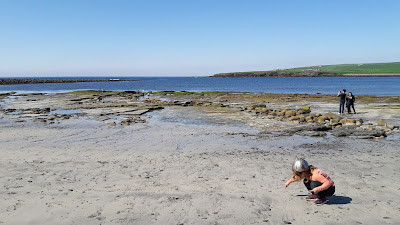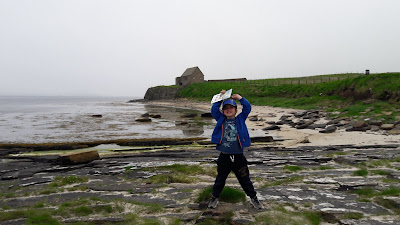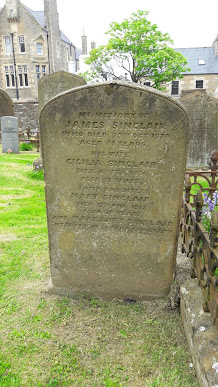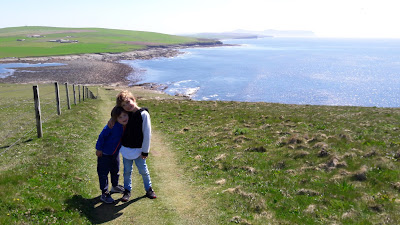I have deep Orcadian roots, yet before this trip I had never so much as stepped foot on the Orkney isles. Why, you may ask? Well, the location is part of it...
Looking at a globe, you have to trace your finger to the furthest north-western reaches of Eurasia, jump across the Channel to Britain, keep going north until England gives way to Scotland and Scotland gives way to the ocean. There, across one of the most treacherous stretches of water on the planet, you find the tiny Orkney archipelago.
The inspiration for this trip lay with my Uncle Peter. A great man, now sorely missed, who convinced and cajoled his close family up to the land of our forebears in May 2018. All in all, 17 of us made the pilgrimage under his instruction and I can’t thank him enough for it. Quite unexpectantly, I found one of my favourite places on earth.
TO THE NORTH
We took a flight to Inverness, jumped in a car, passed the sadness of Culloden Moor, crossed the Moray Firth and then headed up the map.
It was a beautiful road, taking us in and out from lochs to villages, forests and then back out to the north-east drag of the coast. Passed places with names like Glen Morangie, Golspie, Helmsdale and Ramscraigs, before jutting due north and across the wind-swept moors. They were so desolate and overbearing, it took me quite by surprise.
Eventually we reached the small port of Scabster and boarded a ferry to Stromness and the “Mainland”, the largest of the islands where the majority of Orkadians reside.
Our journey was relatively calm, but foggy. I scoured the sea around us for the resident orcas, but to no avail. I could see from the map that our ferry was to pass the island of Hoy, but I did not see it until we were up close, the fog cleared and the giant cliffs emerged. Orangey-brown, topped with green, these were the highest sea-cliffs in the UK, rising sheer out of the waves to well over a 1,000 feet. Seabirds abounded, skimming the water in flocks, swirling on the winds and then disappearing into the vastness of the cliffs.
The Old Man of Hoy did not disappoint. A nearly 500 foot sea-stack, still standing proud against the wind and waves that will eventually swallow it.
The sun set as we spotted the Mainland, cleared Hoy and then turned to port and then to starboard into the small port town of Stromness, our home for a week.
Pretty knackered, we wound our way down the small streets to our harbourside house. Kids straight to bed and then a quick peer out the window to the say goodnight to the sea before we also hit the hay. In the gloom, something caught my eye Would you believe it, a harbour seal peaking out the water right at me, not 10 meters away. He dipped back down, then emerged a few meters further back. A final glance and he way gone. What an introduction to Orkney!
THE FAMILY ARRIVES
I am half Scottish and half of that Scottishness is Orcadian. My name is the giveaway. “Sinclair” is as Orcadian as it comes. Up until my grandfather, this had been the home of my ancestors for generation upon generation. The connection was evident from our first walk around the narrow streets of Stromness, with my surname hanging over more than one shop.
I took to the town immediately. A measure of affluence from its time as the supply stop for the Hudson Bay Company (look up Canadian history 101 if you want find out more), helped provide it with grander buildings than its size and location would forecast. Stretching across and right up to the sea, I particularly liked the selection of old pubs, the small charming museum and old bright red lifeboat station dive school.
One by one different parts of my family arrived, having made the journey by different routes, transports and paces. All was plane sailing, except for one of my sisters, whose flight refused to depart from Inverness due to bad weather. There were no such issues in Orkney, where the sun shined and the thermostat reached a shocking 20 plus degrees C on successive days (shocking as the highest ever recorded temperature is 25.6 – you have to remember the latitude is only just below the southern tip of Greenland).
This is the first time I can recall us all travelling en masse and it was rather strange, yet wonderful to all meet in a pub garden of my uncle’s choosing so far from home to plan our stay. For those new to the treasures of these isles, the real issue was how to squeeze just a portion of the highlights into our time together. There can be few such remote places in the world that cramp so much varied interest into such a small space. You have to see it to believe it, and that we did.
A TOUR THROUGH THE AGES
What, to my mind, makes Orkney so special, are the number of impressive layers of history piled on top of each other. While you can occasionally be found in a grand old city (think Palermo, Seville or, above all else, Rome), it is not what you expect on windswept, cold islands at the end of the earth (or at least Eurasia). To give you an idea, I will take a trot through time using a selection of the remarkable places we were lucky enough to visit.
STONE AGE MARVELS
Against all the odds, Orkney contains the best preserved Neolithic remains in the UK, and one of the best in Europe. There are multiple sites and more continue to be excavated every year.
I have to start with Skara Brae. Eroded and dug out of the sands of a beach on the west coast of the Mainland is a near complete Neolithic village, dating from 3100-2500 BC. It is absolutely unique in its age and remarkable state of preservation. You can literally walk around the 5,000 year old passages, looking down into the houses, complete with doors shelves and benches.
It took me by total surprise. If you are lucky, settlements of half this age leave behind base wall or foundation fragments which require serious imagination to transform in to places people actually lived, but Skara Brae required no such taxing of the mind. A 5,000 year old veil was removed.
From Skara Brae, we drove in land to the heart of the Neolithic remains. Strung along and around a narrow strip of land between the Loch of Harray and the Loch of Stenness are marvels. First we came to the Ring of Brodgar. A broad ring of standing stones some 100 m across, rising out of the gorse and surrounded by pre-historic ditch. It is a starkly beautiful place, slightly raised, separating the two lochs. The kids were more than happy, running around the track created by the feats of countless thousands of man-hours 4,000 years ago.
Passing the continued excavations at the Ness of Brodgar, we came upon Stones of Stenness. Five stones remain of an original twelve that formed one of the oldest surviving henges, a thousand years older than Stonehenge. The largest of the stones is 6 meters high, but looked even taller next to the sheep which grazed its base.
Barely a kilometre from these monoliths was perhaps the most impressive of the place we visited on the island, Maeshowe. Rising like a small, green pyramid from the flat land next to the Loch of Harray, is this 5,000 year chambered cairn.
As we approached with the guide, it became clear the scale was even bigger than it looked from afar. This was a good thing, as we had tickets to enter the burial mound and I admit I initially wondered how our whole group would fit in.
We entered through a long, low passage, flanked by large stones. It felt a bit like Indiana Jones, stooping through the tunnel to emerge into a hidden chamber at the heart of the mound. It was very exciting, expressed by wide-eye looks in the kids, illuminated by the electric light switched on within.
The chamber was large, with plenty of room to stand, constructed by concentric layers of long flat stones. As the walls raised to shoulder height, these stones edged inwards over one another to form the roof. It was a remarkable place. To think this place was built twice as far back as the Parthenon and the height of classical Greece.
To my shock there was graffiti on the walls. Not of the common, spray painted kind, but strange etchings carved into the stones. The guide explained that these were not from modern, but medieval tourists. Vikings had opened up the tombs a thousand odd years ago, no doubt took what they found in there, and left behind the largest collection of Viking runes outside of Scandinavia. The most famous is an intricate carving of a dragon, but the one that stuck to the brain was translated by the guide as “Thor and I fucked Helga”.
IRON AGE PLAYGROUND
Orkney also has its fair share of Iron Age remains. We had the pleasure of visiting the Broch of Gurness, on the edge of a bay opposite the isle of Rousay. A broch is a stone tower and in front of us was one of the best preserved brochs in all of Scotland. Still nearly 4 meters high (it is estimated to have originally been twice that height) and surrounded by numerous nooks, crannies, remains of walls and ditches, it proved the kids favourite playground on the island.
The approach to the brock only added to the wonder. For once on our trip, the famed Orkney mist had descended, adding a surreal quality to the over 2,000 year old remains. We were the only visitors and, against my better judgement, we bought the kids matching toy Viking helmets, swords and axes at the entrance. This inevitably lead to a giant mock battle through the site. Being old and mature, I jumped straight in and together had as much fun as I can recently remember.
What made it even better were the two seals popping in and out of the misty waters as we departed.
VIKING STONGHOLD
Viking remnants are scattered throughout Orkney and the blood of Orcadians. The islands were ruled by Norway for some 700 hundred years, only becoming part of Scotland in 1468 as security against the payment of a dowry.
It was ruled by such awesomely named Earls as Sigurd the Mighty and Thorfinn Skull-splitter, before Christianity took hold and, latterly, the earldom passed to the Sinclair family in the late 14th century.
The height of Viking gifts to the future, is the quite unique St Magnus Cathedral in Kirkwall, the capital. Very distinctive, with its red and yellow alternating sandstone, it is a Romanesque wonder. While I hugely enjoyed touring around the inside, I found the circumnavigation of the outside rather less uplifting.
Looking to keep the kids entertained, I for some reason suggested they look round the graveyard for any namesakes, this being a deeply Sinclair isle and all. Finding one was fine. Two, three, four, five… twenty plus far less fun. Even worse, the kids found more than one inscription with my full name, middle name and all. That was a bit too much for me. The kids found my only semi-shock horror a little too amusing for my liking…
WORLD WAR FORTRESS
Situated between the isles of Hoy, Graemsay, Flotta, Buray, South Ronaldsay, Mainland and others, is one of the great deep sea harbours of the world – Scapa Flow.
We drove around much of its perimeter, findings remnants of what was the main fortified base of the Royal Navy in WWI and WWII. From massive gun emplacements at its westward entrance (yet another playground for the kids), via the buoy that marks the tragic resting place of HMS Royal Oak, to sunken block ships on the eastern approaches and the Italian chapel built by some of the thousands of Italian POWs that were imprisoned here in WWII. It was fascinating.
I found the trip down to the water’s edge near the Royal Oak really quite emotional. Some 833 sailors lost their lives when the aged battleship was sunk by a daring German U-boat mission at the start of WWII. Such a waste. I could see how much simply talking about it upset my father, an ex-naval man himself.
 |
| Wrong era canon, but the kids aren't picky |
Looking further out, I imagined all the other ships sitting on the floor of Scapa Flow. Now largely empty, this body of water once harboured one of the largest collections of naval metal ever assembled. At the end of WWI, alongside the British ships, it became the final resting place of the Imperial German High Seas fleet. Not wanting to wait for Versailles to determine their fate, the commander ordered the fleet scuttled, sending 53 ships to the sandy depths. More on that in part two of this blog.
FAST FORWARD
For the first time in a long time, the islands are again seeing masses of massive ships. No longer battleships or longboats, but rather cruise ships. A combination of world class sites and being convenient stop on the way to Iceland, have made it the most popular cruise ship destination in the UK. While bringing increased prosperity to the island, I do so hope it is not overwhelmed. There are only so many coach loads of cruise-ship passengers that can parade around before some of the charm is lost. For now it is though safe to say that Orkney is thoroughly charming and welcoming.
This brief trawl through history and historical sites we visited is but a selection of what Orkney has to offer. The depth and extent of its wonders amazed me and, to be honest, I fell in love with the place.
























